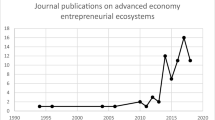Abstract
In its most abstract sense, an ecosystem is a biotic community, encompassing its physical environment, and all the interactions possible in the complex of living and nonliving components. Economics has always been about systems that explain differential output and outcomes. However, economics has generally ignored the role of entrepreneurship in economic systems, just as entrepreneurship studies have largely overlooked the role of systems in explaining the prevalence and performance of entrepreneurship. The entrepreneurial ecosystem approach has the promise to correct these shortcomings. Its two dominant lineages are the regional development literature and the strategy literature. Both lineages share common roots in ecological systems thinking, providing fresh insights into the interdependence of actors in a particular community to create new value. But studies of both regional development and strategic management have largely ignored the role of entrepreneurs in new value creation. In this paper, we will outline contributions to the entrepreneurial ecosystem approach and conclude with a promising new line of research to our understanding of the emergence, growth, and context of start-ups that have achieved great impact by developing new platforms.

Similar content being viewed by others
Notes
References
Acemoglu, D., & Robinson, J. A. (2013). Why nations fail: the origins of power, prosperity, and poverty. Crown Business.
Acs, Z. J., & Audretsch, D. B. (1988). Innovation in large and small firms: an empirical analysis. American Economic Review, 78, 678–690.
Acs, Z. J., Astebro, T., Audretsch, D., & Robinson, D. T. (2016). Public policy to promote entrepreneurship: a call to arms. Small Business Economics, 47(1), 35–52.
Acs, Z. J., Autio, E., & Szerb, L. (2014). National systems of entrepreneurship: measurement issues and policy implications. Research Policy, 43(1), 476–494.
Acs, Z. J, Estrin, S., Mickziewicz, T. & Szerb, L. (2017). Institutions, entrepreneruship and growth: the role of national entrepreneruial ecosystems, London School of Economics, SSRN. http://ssrn.com/abstract=2912453.
Adner, R. (2017). Ecosystem as structure. an actionable construct for strategy. Journal of Management, 43(1), 39–58.
Adner, R., Oxley, J. E., & Silverman, B. S. (Eds.). (2013). Collaboration and competition in business ecosystems. Advances in Strategic Management, Volume 30. Bingley: Emerald.
Adner, R., & Kapoor, R. (2010). Value creation in innovation ecosystems: how the structure of technological interdependence affects firm performance in new technology generations. Strategic Management Journal, 31(3), 306–333.
Anselin, L., Varga, A., & Acs, Z. J. (1997). Local geographic spillovers between university research and high technology innovations. Journal of Urban Economics, 42, 422–448.
Amin, A., & Thrift, N. (1994). Globalization, institutions, and regional development in Europe. Oxford: Oxford University Press.
Audretsch, D. B., & Lehmann, E. E. (2014). Corporate governance and entrepreneurial firms. Foundations and Trends in Entrepreneurship, 10(1/2), 1–160.
Audretsch, D. B., Kuratko, D., & Link, A. (2015). Making sense of the elusive paradigm of entrepreneurship. Small Business Economics, 45(4), 713–728.
Autio, E., & Thomas, L. (2014). Innovation ecosystems. The Oxford Handbook of Innovation Management, (pp 204–288). Oxford: Oxford Universitys Press, not scientific publishers
Autio, E., & Thomas, L. D. W. (2016). Tilting the playing field: towards an endogenous strategic action theory of ecosystem. In S. Nambisan (Ed.), Tilting the playing field: towards an endogenous strategic action theory of ecosystem creation. New Jersey: World Scientific Publishing.
Auerswald, P. & Dani. (2017). The adaptive lifecycle of entrepreneurial ecosystems: the biotechnology cluster, Small Business Economics (this issue).
Bain, J. S. (1959). Industrial organization. New York: John Wiley & Sons.
Becattini, G. (1990). The Marshallian industrial district as a socio-economic notion. In F. Pyke, G. Becattini, & W. Sengenberger (Eds.), Industrial districts and inter-firm co-operation in Italy. Geneva: International Institute for Labour Studies.
Boettke, P. J., & Coyne, C. J. (2009). Context matters: institutions and entrepreneurship. Foundations and Trends in Entrepreneurship, 5(3), 135–209.
Brown & Mason, (2017) “Looking inside the spiky bits: a critical review and conceptualization, small business economics (this issue).
Bruns, Bosma, N., Sanders, M. & Schramm (2017), Searching for the existence of entrepreneurial ecosystems, small business economics, (this issue).
Coase, R. (1937). The nature of the firm. Economica, new series, 4(16), 386–405.
Cooke, P., Gomez Uranga, M., & Etxebarria, G. (1997). Regional innovation systems: institutional and organizational dimensions. Research Policy, 26, 475–491.
Davis, S., Haltiwanger, J., & Schuh, D. (1996). Job creating and job destruction. Cambridge: The MIT Press.
Evans, D. S., & Schmalensee, R. (2016). Matchmakers: the new economics of multisided platforms. Boston: Harvard Business Review Press.
Felf, B. 2012. Start-up communities: Building an Entrepreneurial Ecosystem in your city. John Wiley & Sons, NJ.
Florida, R. (2004). The rise of the creative class. New York: Basic Books.
Frenken, K., Van Oort, F., & Verburg, T. (2007). Related variety, unrelated variety and regional economic growth. Regional Studies, 41(5), 685–697.
Gawer, A., & Cusumano, M. A. (2002). Platform leadership: how Intel, Microsoft, and Cisco drive industry innovation. Boston: Harvard Business School Press.
Glaeser, E. J., Kallal, H. D., Scheinkman, J. A., & Shleifer, A. (1992). Journal of Political Economy, 100(6), 1126–1152.
Henrekson, M., & Johansson, D. (2008). Competencies and institutions fostering high-growth firms. Foundations and Trends in Entrepreneurship, 5(1), 1–80.
Henrekson, M., & Sanandaji, T. (2014). Small business activity does not measure entrepreneurship. Proceedings of the National Academy of Sciences, 111(5), 1760–1765.
Iansiti, M., & Levien, R. (2004). The keystone advantage: what the new dynamics of business ecosystems mean for strategy, innovation, and sustainability. Cambridge: Harvard Business Press.
Isenberg, D. (2010). How to Start an Entrepreneurial Revolution, Harvard Business Review, June, 41–51.
Jacobides, M. G., Knudsen, T., & Augier, M. (2006). Benefiting from innovation: value creation, value appropriation and the role of industry architectures. Research Policy, 35(8), 1200–1221.
Li, W., Badr, Y., & Biennier, F. (2012). Digital ecosystems: challenges and prospects. In Proceedings of the International Conference on Management of Emergent Digital EcoSystems (117–122). ACM.
Kuratko, Fisher, Bloodgood & Hornsby. (2017). The Paradox of New Venture Legitimation in an Entrepreneurial Ecosystem, Small Business Economics (this issue).
Marshall, A. (1920). Principles of economics. London: MacMillan and co..
Mason, C., & Brown, R. (2013). Creating good public policy to support high-growth firms. Small Business Economics, 40(2), 211–225.
Miller, D. (2015). Campus as frontier: high growth student at U.S. colleges and universities. Doctoral Dissertation, School of Public Policy, George Mason University, Fairfax Virginia.
Miller, D. & Acs, Z. J. (2017). The Campus as Entrepreneurial Ecosystem: The University of Chicago, Small Business Economics (this issue).
Moore, J. F., (1993). Predators and Prey: A New Ecology of Competition, Harvard Business Review, 71(30, 76.
Moore, J. (1996). The death of competition: leadership and strategy in the age of business ecosystems. New York: HarperBusiness.
Parker, G. G., & Van Alstyne, M. W. (2005). Two-sided network effects: a theory of information product design. Management Science, 51(10), 1494–1504.
Pitelis, C. (2012). Clusters, entrepreneurial ecosystem co-creation, and appropriability: a conceptual framework. Industrial and Corporate Change, 21(6), 1359–1388.
Porter, M. E. (1998). On competition. Boston: Harvard Business School Press.
Rochet, J. C., & Tirole, J. (2003). Platform competition in two-sided markets. Journal of the European Economic Association, 1(4), 990–1029.
Rochet, J.-C., & J. Tirole. (2006). Two-sided markets: where we stand, Rand Journal of Economics, 37(3).
Shane, S., & Venkatraman, S. (2000). The promise of entrepreneurship as a field of research. Academy of Management Review, 25, 217–226.
Stam, E. (2015). Entrepreneurial ecosystems and regional policy: a sympathetic critique. European Planning Studies. 1–11.
Stam, E. (2013). Knowledge and entrepreneurial employees: a country level analysis. Small Business Economics, 41(4), 887–898.
Stam, E., & Spigel, B. (2017). Entrepreneurial ecosystems. In R. Blackburn, D. De Clercq, J. Heinonen, & Z. Wang (Eds.), The SAGE Handbook of Small Business and Entrepreneurship. London: SAGE. forthcoming.
Stam, E. & Saberi, S. (2017). Unicorns around the globe. StartupJuncture.
Stangler, D., & Bell-Masterson, J. (2015). Measuring an entrepreneurial ecosystem. Kansas City: Kauffman Foundation Research Series on City, Metro, and Regional Entrepreneurship.
Stenholm, P., Acs, Z. J., & Wuebker, R. (2013). Exploring country level institutional arrangements on the rate and type of entrepreneurial activity. Journal of Business Venturing, 28(1), 176–193.
Sussan, F. & Acs, Z.J. (2017). The digital entrepreneurial ecosystem, Small Business Economics, (this issue).
Tansley, A. J. (1935). The use and abuse of vegetational concepts and terms. Ecology, 16, 284–307.
Terjesen, S., Acs, Z. J., Audretsch, D. B., Hechavarria, D., Stam, E., and White, R. (2017) Entrepreneurial ecosystems: the search for performance, University of Tampa, unpublished.
Turner, F. (1894) The Significance of the frontier in American history. Madison: State Historical Society of Wisconsin
Uzunca, B., Sharapov, S., & Tee, R. (2016). Competition and cooperation in ecosystems: how industry evolution and governance inseparability shape value capture over time. Working paper.
Williamson, P., & De Meyer, A. (2012). Ecosystem advantage. California Management Review, 55(1), 24–46.
Zahra, S. A., & Nambisan, S. (2011). Entrepreneurship in global innovation ecosystems. AMS Review, 1(1), 4.
Acknowledgements
The authors would like to thank Bilgehan Uzunca for useful suggestions on an earlier version of this introduction.
Author information
Authors and Affiliations
Corresponding author
Rights and permissions
About this article
Cite this article
Acs, Z.J., Stam, E., Audretsch, D.B. et al. The lineages of the entrepreneurial ecosystem approach. Small Bus Econ 49, 1–10 (2017). https://doi.org/10.1007/s11187-017-9864-8
Published:
Issue Date:
DOI: https://doi.org/10.1007/s11187-017-9864-8




